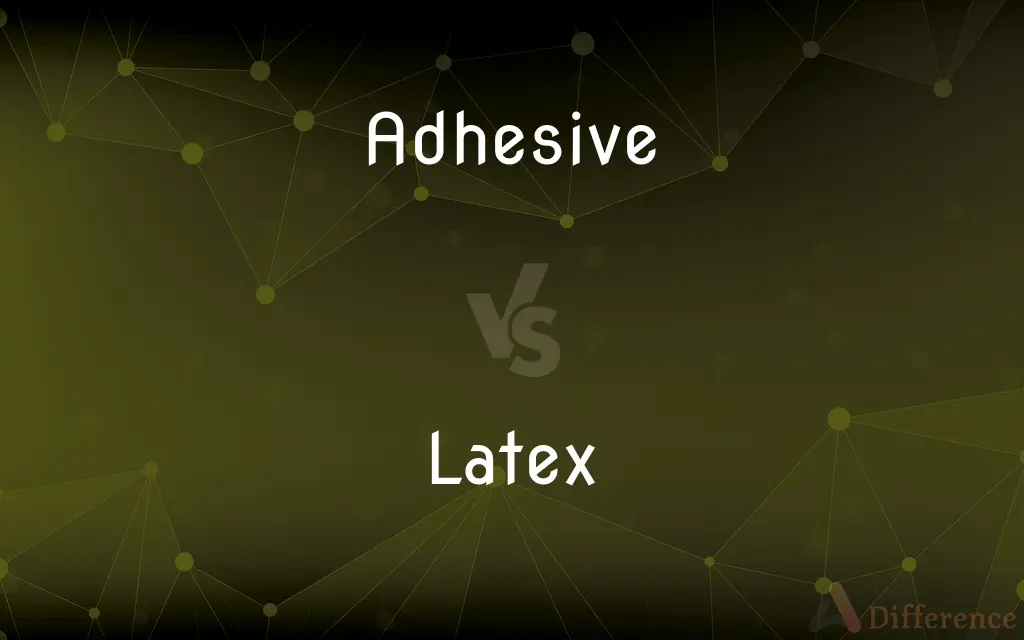Adhesive vs. Latex — What's the Difference?
Edited by Tayyaba Rehman — By Maham Liaqat — Updated on March 30, 2024
Adhesive is a substance used for sticking objects together, while latex is a natural or synthetic rubber used in various products.

Difference Between Adhesive and Latex
Table of Contents
ADVERTISEMENT
Key Differences
Adhesive and latex serve distinct purposes in various industries and applications. Adhesives are substances applied to surfaces to bond them together through surface attachment, which can be temporary or permanent, depending on the chemical composition of the adhesive. On the other hand, latex is a milky fluid found in many plants, most notably the rubber tree, which can be processed into natural rubber. This natural rubber latex is valued for its elasticity, waterproof properties, and resistance to tear and wear. It is used in a wide range of products, from medical devices like gloves and catheters to consumer goods like balloons and rubber bands. Additionally, synthetic latexes are produced, mimicking the properties of natural latex for use in paints, adhesives, and coatings.
While adhesives are primarily chosen for their bonding strength and durability, latex materials are selected for their flexibility, elasticity, and protective qualities. Adhesives can range from weak paper glues to strong epoxies used in construction, each formulated for specific materials and conditions. Latex, in contrast, is prized for its ability to stretch and return to its original shape, making it ideal for products requiring flexibility and resilience.
The application methods for adhesives and latex also differ significantly. Adhesives are usually applied in a liquid or semi-liquid form, requiring time to set and cure, thereby forming a strong bond between the surfaces. In contrast, latex can be used as a raw material in the manufacturing process, where it is molded, dipped, or extruded to form the final product. Additionally, liquid latex can be applied as a coating to surfaces for protection or waterproofing.
In terms of environmental impact, both adhesives and latex have considerations to keep in mind. Many adhesives contain volatile organic compounds (VOCs) and other hazardous substances that can pose health and environmental risks during manufacture and use. Conversely, natural rubber latex is a renewable resource, but latex production can lead to deforestation and biodiversity loss. Synthetic latexes, while avoiding some of the environmental impacts of natural latex production, can also have significant environmental footprints due to the chemicals and energy used in their synthesis.
Despite their differences, adhesives and latex can be complementary in certain applications. For example, latex-based adhesives combine the elasticity and flexibility of latex with the bonding power of adhesives, making them useful in applications where movement or flexibility is required alongside adhesion.
ADVERTISEMENT
Comparison Chart
Nature
Bonding substance
Natural or synthetic rubber
Primary Use
To adhere or bond materials together
Elasticity, protection, waterproofing
Material Type
Polymers, resins, biological sources
Rubber tree sap, synthetic polymers
Key Properties
Bonding strength, durability
Elasticity, flexibility, waterproof
Applications
Construction, manufacturing, DIY
Medical devices, clothing, consumer goods
Compare with Definitions
Adhesive
A material capable of holding objects together by adhesion.
Wallpaper adhesive is specifically formulated to hang wall coverings securely.
Latex
A liquid used in paints and coatings for flexibility.
Latex paint dries quickly and offers a durable, washable surface.
Adhesive
A substance that binds materials together by surface attachment.
Super glue is an adhesive used for fast bonding of non-porous surfaces.
Latex
A milky sap produced by rubber trees used in making rubber.
The latex collected from rubber trees is processed into natural rubber products.
Adhesive
A substance applied for temporary or permanent bonding.
Removable adhesive allows posters to be hung without damaging walls.
Latex
Material used in medical devices for its non-reactive properties.
Latex catheters are widely used due to their flexibility and biocompatibility.
Adhesive
A compound used in construction for bonding building materials.
Tile adhesive is used to securely fix tiles to floors or walls.
Latex
A natural rubber material known for its elasticity.
Latex gloves are preferred for their stretchability and comfort.
Adhesive
A chemical mixture that causes adhesion through curing or drying.
Epoxy adhesive provides a strong, durable bond for metal and plastic.
Latex
A synthetic material mimicking the properties of natural latex.
Synthetic latex is used in mattresses for its durability and resistance to allergens.
Adhesive
Adhesive, also known as glue, cement, mucilage, or paste, is any non-metallic substance applied to one or both surfaces of two separate items that binds them together and resists their separation.The use of adhesives offers certain advantages over other binding techniques such as sewing, mechanical fastenings, or welding. These include the ability to bind different materials together, the more efficient distribution of stress across a joint, the cost-effectiveness of an easily mechanized process, and greater flexibility in design.
Latex
Latex is a stable dispersion (emulsion) of polymer microparticles in water. Latexes are found in nature, but synthetic latexes are common as well.
Adhesive
Tending to adhere; sticky.
Latex
A milky fluid found in many plants, such as poppies and spurges, which exudes when the plant is cut and coagulates on exposure to the air. The latex of the rubber tree is the chief source of natural rubber.
Adhesive
Gummed so as to adhere.
Latex
The colorless or milky sap of certain plants, such as the poinsettia or milkweed, that coagulates on exposure to air.
Adhesive
Tending to persist; difficult if not impossible to shake off
"He feels an adhesive dread, a sudden acquaintance with the ... darker side of mankind" (George F. Will).
Latex
A polymer emulsion consisting of such sap obtained from rubber trees, used to manufacture various thin elastic products such as balloons, disposable gloves, and medical and contraceptive devices. Some people are allergic to this substance. Also called natural rubber latex.
Adhesive
A substance, such as paste or cement, that provides or promotes adhesion.
Latex
A similar material made from polymers derived from petroleum; synthetic latex.
Adhesive
Sticky; tenacious, as glutinous substances
Adhesive material
Adhesive tape
Latex
Latex paint.
Adhesive
Apt or tending to adhere; clinging
Latex
A clear liquid believed to be a component of a humour or other bodily fluid esp. plasma and lymph
Adhesive
A substance, such as glue, that provides or promotes adhesion
Latex
The milky sap of several trees that coagulates on exposure to air; used to make rubber.
Adhesive
Sticky; tenacious, as glutinous substances.
Latex
An emulsion of rubber in water, used in adhesives and the like.
Adhesive
Apt or tending to adhere; clinging.
Latex
(uncountable) Natural latex rubber, especially non-vulcanized rubber, such as is used in making latex gloves, latex condoms, and latex clothing.
Adhesive
A substance that unites or bonds surfaces together
Latex
A milky or colored juice in certain plants in cavities (called latex cells or latex tubes). It contains the peculiar principles of the plants, whether aromatic, bitter, or acid, and in many instances yields caoutchouc upon coagulation. The lattex of the India rubber plant produces the rubber of commerce on coagulation.
Adhesive
Tending to adhere
Latex
Any aqueous emulsion of finely divided rubber or plastic particles, especially such an emulsion used as a base for paint; as, a latex paint.
Latex
A milky exudate from certain plants that coagulates on exposure to air
Latex
A water-base paint having a latex binder
Common Curiosities
What is adhesive?
Adhesive is a substance used for bonding surfaces together.
What is latex?
Latex can refer to natural rubber derived from plant sap or synthetic materials with similar properties.
Can adhesives be made from latex?
Yes, latex-based adhesives combine the properties of both materials for flexible bonding solutions.
What are the uses of latex?
Latex is used in medical devices, clothing, and various rubber products for its elasticity and durability.
Is latex always natural?
No, latex can be either natural, derived from rubber trees, or synthetically produced.
How do adhesives work?
Adhesives work by creating a chemical bond between surfaces, holding them together.
What's the difference between latex and rubber?
Latex is a raw material that can be processed into rubber, which is more durable and used in products.
How is natural latex harvested?
Natural latex is harvested by tapping rubber trees to collect the sap.
Are all adhesives toxic?
Not all, but some adhesives contain toxic substances; it depends on their chemical formulation.
Can latex cause allergies?
Yes, natural rubber latex can cause allergic reactions in some individuals.
Do adhesives require curing?
Many adhesives require curing, a process where they solidify to form a bond.
Are there environmental concerns with adhesive production?
Yes, the production of some adhesives can release harmful VOCs and have other environmental impacts.
How are synthetic latexes made?
Synthetic latexes are created through chemical processes that polymerize monomers into rubber-like materials.
What are the advantages of latex over synthetic rubbers?
Latex offers superior elasticity and biodegradability, but synthetic rubbers can be tailored for specific properties and applications.
Can latex be used in adhesives?
Yes, latex is used in some adhesive formulations to impart flexibility and strength.
Share Your Discovery

Previous Comparison
Fad vs. Trend
Next Comparison
Altimeter vs. BarometerAuthor Spotlight
Written by
Maham LiaqatEdited by
Tayyaba RehmanTayyaba Rehman is a distinguished writer, currently serving as a primary contributor to askdifference.com. As a researcher in semantics and etymology, Tayyaba's passion for the complexity of languages and their distinctions has found a perfect home on the platform. Tayyaba delves into the intricacies of language, distinguishing between commonly confused words and phrases, thereby providing clarity for readers worldwide.














































